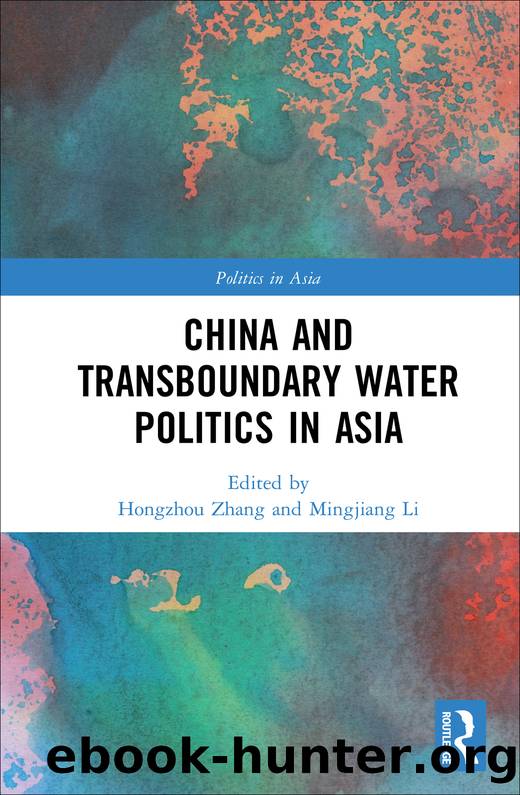China and Transboundary Water Politics in Asia by Hongzhou Zhang & Mingjiang Li

Author:Hongzhou Zhang & Mingjiang Li [Zhang, Hongzhou & Li, Mingjiang]
Language: eng
Format: epub
ISBN: 9780367375591
Google: sF6XxgEACAAJ
Goodreads: 50916282
Publisher: Routledge
Published: 2019-09-30T00:00:00+00:00
Motive of joint development: national strategy versus local development
Chinaâs attempts to facilitate cooperation on the Yalu River and Tumen River is a result of fundamental adjustments in Chinaâs national and regional development strategies in the context of substantial geopolitics changes. The Chinese central government conducted the overall strategic planning for transboundary rivers and actively facilitated its implementation. To develop the local economy, the local government also acted in line with the strategic arrangements from the central government, facilitating the river basin cooperation and regional cooperation with the rivers as a vehicle.
The strategy of developing the coastal regions, encouraging and facilitating provinces on Chinaâs eastern coast to pioneer the development was first implemented in China in the late 1970s (i.e. the opening and reform policy featuring âinternal reform and opening up to the outside worldâ). Up to the 1980s, the centre of gravity in the global economy started to move eastwards to the Asia-Pacific region where the economy of Northeast Asia flourished. Therefore, leveraging external opportunities for boosting the regional economy in Northeast China and for building a stable regional environment in Northeast Asia has become an important issue on the agenda of the central government of China. Therefore, the local government is seeking ways to leverage its geographical location, exploring matching points between international and national strategies and breaking through the bottleneck to boost the development of traditional industrial bases in Northeast China.
According to several researchers and experts in Northeast Normal University and Jilin Academy of Social Sciences, study on the feasibility of regional trade between the USSR and Jilin Province in 1984 shows that China had the legitimate rights for sea access and navigation from the Tumen River. After an in-depth analysis of the political and economic situation in Northeast Asia, the sea access and navigation history of the Tumen River and its hydrology, and another meticulous study on the restoration of its sea access and navigation rights as well as the plan and measures for the development along the Tumen River, a proposal was submitted to the government in 1985 for the restoration of Chinaâs sea access rights through the Tumen River. By the end of 1986, this proposal attracted the attention of Huan Xiang, renowned expert in international affairs and chairman of Pacific Economic Cooperation Council (PECC-China) at the time. It was he who brought up the suggestion to the central government.
In March and May 1987, Song Jian commissioned the senior leaders of the State Oceanic Administration and experts in ocean policies to conduct a survey in Jilin for the restoration of sea access and navigation rights on the Tumen River, hence arousing keen interest of the Provincial Government of Jilin in the restoration of sea access rights. On 14 and 20 May 1987, the Peopleâs Government of Jilin Province and the State Oceanic Administration respectively sought suggestions from the State Council and proposed the restoration of Chinaâs sea access rights on the Tumen River. The navigation route development of the Tumen River has therefore been put
Download
This site does not store any files on its server. We only index and link to content provided by other sites. Please contact the content providers to delete copyright contents if any and email us, we'll remove relevant links or contents immediately.
Zero to IPO: Over $1 Trillion of Actionable Advice from the World's Most Successful Entrepreneurs by Frederic Kerrest(4063)
Machine Learning at Scale with H2O by Gregory Keys | David Whiting(3640)
Harry Potter and the Goblet Of Fire by J.K. Rowling(3612)
Never by Ken Follett(3532)
Ogilvy on Advertising by David Ogilvy(3338)
Shadow of Night by Deborah Harkness(3177)
The Man Who Died Twice by Richard Osman(2811)
Book of Life by Deborah Harkness(2721)
My Brilliant Friend by Elena Ferrante(2704)
How Proust Can Change Your Life by Alain De Botton(2615)
0041152001443424520 .pdf by Unknown(2599)
Will by Will Smith(2581)
The Tipping Point by Malcolm Gladwell(2562)
How to Pay Zero Taxes, 2018 by Jeff A. Schnepper(2503)
Purple Hibiscus by Chimamanda Ngozi Adichie(2491)
Hooked: A Dark, Contemporary Romance (Never After Series) by Emily McIntire(2423)
Rationality by Steven Pinker(2150)
Borders by unknow(2119)
Daughter of Smoke and Bone by Laini Taylor(2083)
